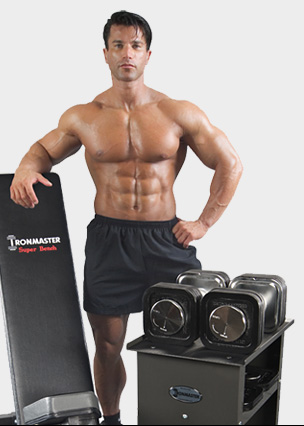Blog
Importance of Muscular Tension for Maximized Workouts

At Ironmaster, we’re all about simplicity and efficiency. If you find that you have plateaued on your lifts, there may be a simple fix. By squeezing your muscles and applying maximum tension to each muscle contraction and repetition, you can catapult out of your plateau to new heights. So how do you do this? One of the most important contributors to muscular growth is the tension that muscle fibers experience under load. The more muscular tension, the more high-threshold motor units (aka motor neurons and skeletal muscle fibers) that are recruited. In order to maximize efficiency and get the most results from your home gym workout, you need to squeeze your targeted muscles during all phases of the movement no matter what exercise you are doing. There are three phases of a muscle’s contraction and you need to focus on the squeeze during all of them. Here’s a quick explanation of the different phases:
Isometric Contraction – Tension is generated, but there are no changes in length.
Eccentric Contraction – Tension is created but is not sufficient enough to overcome the external load on the muscle, so the muscle fibers lengthen as they contract. An example of an eccentric contraction is when you are doing a bench press and you lower the weight to your chest.
Concentric Contraction – Tension is created and is sufficient enough to overcome the load, resulting in the muscle fibers shortening as they contract. An example of this is when you raise the dumbbell up during bench press away from your chest. During each of these phases, it’s important that you squeeze the muscle during the movement. This helps your mind remain focused on using the target muscle group.
How do we know that intentionally squeezing your muscles during the movement is beneficial?
EMG machines, or Electromyography machines, have long been used to compare the level of muscular activity between different workouts. EMGs work by measuring the electrical activity of muscles at rest and during contraction. A muscle is contracted when nerves fire electrical signals called impulses. EMGs provide us with the ability to compare the level of high-threshold motor units being involved in a movement.
If you were to attach EMG electrodes from an electromyography machine to your bicep and lightly flex it, you would see a pretty significant amount of electrical activity on the screen. If you put all of your effort into flexing your bicep, you would see even more electrical activity on the screen as more motor neurons are firing the harder you flex. The harder you flex or squeeze your bicep, the more tension that is created and the more muscle fibers that are being recruited. So if you squeeze harder during a repetition of an exercise, an EMG will show more muscle activity.
The squeeze and its relationship to the mind-muscle connection
You may have heard the term “mind-muscle connection” thrown around before. Thinking about the “squeeze” is a great step towards achieving a better mind-muscle connection, and will help increase the number of muscle fibers being used when performing a lift.

With each type of lift, there are primary and secondary movers. During the bench press, your pectoralis major is the primary mover and your triceps and deltoids are the secondary movers. Generally speaking, you try to target and isolate the primary mover. Focusing on the squeeze and forming a good mind-muscle connection will help you maximize the amount of work done by the target, primary muscle group, and take away work from the secondary movers. This will help you maximize your gains from workout to workout.
To exemplify this, think of it this way. You can bench press 225 pounds for 8 repetitions. However, because you don’t focus on the squeeze of your pecs throughout the movement and have poor mind-muscle connection your chest is really only doing 60% (135lbs) of the work while your secondary movers (triceps and deltoids) are doing the other 40% (90lbs) of the work. Until you habitually develop a good mind-muscle connection, it may be beneficial if you drop the weight down to 200lbs and focus on the squeeze resulting in 90% (180lbs) chest recruitment and 10% (20lbs) triceps/deltoids recruitment. In this example, even though you have dropped the total weight, you are actually doing more work with your chest because of the focus on the squeeze and the improved mind-muscle connection. If you don’t like the idea of switching weights back and forth to find the sweet spot, consider checking out our adjustable dumbbells with quick-lock technology which provide you with an easy way to quickly adjust the weight. If you’re ready to make serious gains in both strength and size, remember to make every single repetition count by focusing on the squeeze and mind-muscle connection. If you need home gym equipment that is both strong and easily adjustable for maximized workouts, shop Ironmaster today!

No Comments Yet